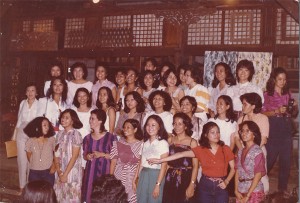Epilogue to Press Freedom and Martial Law
Epilogue to Press Freedom and Martial Law
By Mila Astorga-Garcia

WOMEN (Women Writers in Media Now) circa 1983: some were forced to resign, interrogated, arrested and/or tortured.
The Dumaguete Times case which happened in 1969, three years before martial law, involved the arrest, torture and detention of all the paper’s staffers, and the effective closure of the newspaper, only five months after it was established. The paper published stories which were unflaterring to the powerful landlords and politicians in Negros island, such as student unrest in a university, and a landgrabbing case involving the barb-wiring of tenants’ lands.
Concerned for the safety of the detained Dumaguete Times staffers, the National Press Club, headed by the late Antonio Zumel, launched a fundraising campaign to free the detainees. Lawyer Voltaire Garcia, Zumel, then Senator Doy Laurel, journalists Jose F. Lacaba of the Free Press, and Rodolfo Tupas, editor of The Sunday Times magazine, were among the first to visit the detainees at the Cadiz City jail.
A battery of 12 lawyers headed by Voltaire Garcia, and which included Jose W. Diokno, Lorenzo Tanada, Juan T. David, among others, volunteered legal assistance to the the Dumaguete Times staffers. The trumped-up charges against them were summarily dropped during the preliminary investigation, which was announced by the Defense Department.
While the press freedom fight for the Dumaguete Times staffers was successful, repression against the media went on until the suspension of the writ of habeas corpus and the declaration of martial law. Media offices were raided and closed; journalists were arrested and detained; and government bureaucracy watchdogs on media were created. “The Philippine Press: What are the boundaries of press freedom,” an article published in the defunct Business Day and Filipina II, documented media repression during the martial law years.
And even with the lifting of martial law, media repression took various forms, from intimidating journalists through interrogations at military camps (Ceres Doyo and other women journalists), forced resignation of editors critical of martial law, the “new society,” and the “new republic” (the Letty Magsanoc case), to the closure of media establishments and arrest of all staffers (Joe Burgos of Ang Malaya), not to mention continued media repression in the provinces which were not covered by the national press.
Such repression continuing after martial law eventually led to the phenomenon described as the “radicalization” of the Philippine media, which was documented in the book, The Press Under Siege, Vol II, published by the NPC in 1985. Media practitioners continued to write, broadcast, document stories on human rights violations, such as the killing of Macliing Dulag, the tribal leader who was shot dead by the military because he led the Kalinga tribes against the Chico Dam project; the case of Dr. Bobby de la Paz who was also shot dead due to his medical work among the poor in Catbalogan Samar; and many others.
These days, journalists are summarily executed, some even killed covering public events (the Ampatuan massacre, where 34 of the 57 killed were journalists) and while broadcasting in their studios – a phenomenon that led to the making of a feature film titled “Deadline,” based on the continuing repression of journalists in the country.



Comments (0)